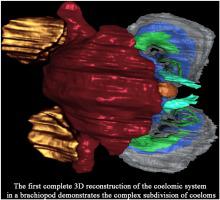Our official English website, www.x-mol.net, welcomes your
feedback! (Note: you will need to create a separate account there.)
Anatomy of the coelomic system in Novocrania anomala (Brachiopoda, Craniiformea) and relationships within brachiopods
Zoology ( IF 1.6 ) Pub Date : 2021-02-01 , DOI: 10.1016/j.zool.2020.125884 Feodor A Plandin 1 , Elena N Temereva 2
Zoology ( IF 1.6 ) Pub Date : 2021-02-01 , DOI: 10.1016/j.zool.2020.125884 Feodor A Plandin 1 , Elena N Temereva 2
Affiliation

|
Brachiopoda is a relict phylum of marine benthic animals that have not been adequately studied with modern microscopy methods. Microscopic study may provide useful information on the evolution of the brachiopod body plan and brachiopod phylogeny. Understanding the organisation of the coelomic system is important because of its role in body form and compartmentalisation. Most brachiopods are considered to have a bipartite coelomic system; the only known exception is Lingulida, which have a tripartite coelomic system. In the present study, we provide the first complete 3D reconstruction of the coelomic system in the craniide brachiopod Novocrania anomala (Müller, 1776). Its coelomic system consists of the following five main parts, which are entirely separated from each other: 1) a pair of large brachial canals; 2) a complex system of paired small brachial canals and a perioesophageal coelom; 3) frontal coelomic chambers; 4) a main trunk coelom, which includes several semi-detached muscular chambers and mantle sinuses; and 5) a pair of posterior adductors chambers. These results indicate that the coelomic system of N. anomala (and perhaps of other craniides) is complex and cannot be considered to be bipartite or tripartite. The frontmost part of the coelomic system is represented by a pair of frontal chambers, which are considered to be a part of the lophophore but which are derived from dorsal mantle fold extensions and thus may be a part of the trunk coelomic system. A number of similarities were discovered between craniiformean and rhynchonelliformean coelomic systems, including the prominent dorsal projections of the large brachial canals and the morphological features of the perioesophageal coelom. The complex subdivision of the N. anomala trunk coelom is explained by the location and function of muscles, and by the location of several mesenteries.
中文翻译:

Novocrania anomala(腕足类,颅骨)体腔系统的解剖和腕足类动物内部的关系
腕足动物门是海洋底栖动物的残余门,尚未用现代显微镜方法进行充分研究。显微研究可能会提供有关腕足动物体型进化和腕足动物系统发育的有用信息。了解体腔系统的组织很重要,因为它在体型和分隔中的作用。大多数腕足动物被认为具有二分体腔系统;唯一已知的例外是 Lingulida,它具有三方体腔系统。在目前的研究中,我们提供了第一个完整的 3D 重建颅骨腕足类 Novocrania anomala 体腔系统 (Müller, 1776)。它的体腔系统由以下五个主要部分组成,它们彼此完全分开:1)一对大臂管;2) 由成对的小臂管和食管周围体腔组成的复杂系统;3) 额体腔室;4) 一个主干体腔,包括几个半分离的肌腔和地幔窦;5) 一对后内收肌腔。这些结果表明,N. anomala(或许还有其他颅骨科动物)的体腔系统很复杂,不能被认为是二分体或三分体。体腔系统的最前部由一对额腔代表,它们被认为是唇体的一部分,但源自背侧地幔褶皱延伸,因此可能是躯干体腔系统的一部分。发现了颅形目和钩形目动物体腔系统之间的许多相似之处,包括大臂管突出的背侧突出和食管周围体腔的形态特征。异常猪笼草躯干体腔的复杂细分可以通过肌肉的位置和功能以及几个肠系膜的位置来解释。
更新日期:2021-02-01
中文翻译:

Novocrania anomala(腕足类,颅骨)体腔系统的解剖和腕足类动物内部的关系
腕足动物门是海洋底栖动物的残余门,尚未用现代显微镜方法进行充分研究。显微研究可能会提供有关腕足动物体型进化和腕足动物系统发育的有用信息。了解体腔系统的组织很重要,因为它在体型和分隔中的作用。大多数腕足动物被认为具有二分体腔系统;唯一已知的例外是 Lingulida,它具有三方体腔系统。在目前的研究中,我们提供了第一个完整的 3D 重建颅骨腕足类 Novocrania anomala 体腔系统 (Müller, 1776)。它的体腔系统由以下五个主要部分组成,它们彼此完全分开:1)一对大臂管;2) 由成对的小臂管和食管周围体腔组成的复杂系统;3) 额体腔室;4) 一个主干体腔,包括几个半分离的肌腔和地幔窦;5) 一对后内收肌腔。这些结果表明,N. anomala(或许还有其他颅骨科动物)的体腔系统很复杂,不能被认为是二分体或三分体。体腔系统的最前部由一对额腔代表,它们被认为是唇体的一部分,但源自背侧地幔褶皱延伸,因此可能是躯干体腔系统的一部分。发现了颅形目和钩形目动物体腔系统之间的许多相似之处,包括大臂管突出的背侧突出和食管周围体腔的形态特征。异常猪笼草躯干体腔的复杂细分可以通过肌肉的位置和功能以及几个肠系膜的位置来解释。











































 京公网安备 11010802027423号
京公网安备 11010802027423号